Tuesday-Type Content: 50 Things Jeff Likes About Comics.
/![]()
I really liked David Brothers' '50 Things I Like' list he did recently over on 4th Letter, as well as some of the lists he reprinted and linked to as a result. And last time I saw him, David said, as we parted, "hey, you should do a list." Somehow that led to me not being able to sleep past 6 AM on a Sunday morning as I sorted and re-sorted the little sublists I'd do.
Anyway, post-jump: 50 things I like about comics, with hopefully just the right amount of commentary.
5 Great "Eras" for Publishers
DC in the late '50s, early '60s: A legacy that's like the pyramids in Egypt--lovely to look at, but I'm damn glad I didn't have to work on 'em. (Reading Weisinger-era Superman is like having dinner at the home of a wife abuser: you feel sick at your complicity but, you gotta admit, the pot roast is perfect.) The mix of genuine talent being ground under by fierce editorial formula, the considerable resources of the company, and an aggressive approach to creating IP (although at the time it was probably called something like "following the marketplace") paid off in a huge back library of material and properties that DC could reinvent for years to come.
Marvel in the early to mid-'70s: Of course, I'm going to pick this era since it was the era I fell in love with comics, but still: Marvel finally being able to publish as many titles as it wanted, combined with a ton of new talent inspired by Marvel's heyday who had absolutely no conception of what work-for-hire work meant. I mean, it's not just that you had more than twenty issues of a title called Man-Thing; it's that you had Howard The Duck, a character in Man-Thing so popular he got his own book.
Fantagraphics in the early '90s: Los Bros Hernandez were still doing Love & Rockets (at what could be argued was their most ambitious period, if it wasn't for the fact they've always been, and continue to be, outrageously ambitious); Peter Bagge was doing Hate; Clowes was doing Eightball. While none of these books were monthly, their publication schedules were such that if you kept coming to the comic book store every week, it seemed like one of them would pop every sixth visit or so.
Despite all the praise and accolades at the time, I think nobody--not the readers, not the publishers, not the retailers--realized how exceptional a line-up this was. I'm not a sports guy, but the closest analogy that comes to mind is when the 49ers replaced Joe Montana with Steve Young. Sure, we San Franciscans knew we were fortunate to have two great QBs in a row, but we didn't realize how unbelievably fortunate: we also believed that, hey, of course we got two great QBs in a row because the 49ers are the greatest football team in the world, and San Francisco is the greatest city in the world, etc., etc. I think that there was a similar feeling at Fantagraphics that, yeah, these guys are geniuses, absolutely, but when they start to burn out (or slow down), we'll have the next generation of geniuses ready to come up. And when they published the first issue of Acme Novelty Library #1 in 1993, it looked like that would actually be the case. But it wasn't.
Vertigo in the mid- to late-'90s: Preacher, The Invisibles, and (pulled over from the failed Helix line) Transmetropolitan. Also, the last great era of letter pages.
Viz, right here in the mid-'00s: This is my own opinion deliriously unmoored from anything like historical knowledge, but Viz strikes me as generally lazy and complacent, willing to write off its lack of hustle as a commitment to the long haul. So it took Tokyopop licensing and dumping materials cheaply on the shelves to get Viz to step up its publishing schedule, and it took Vertical publishing high-end niche materials to get Viz to dip its fiscally conservative toes into riskier waters. Whether my opinion is at all close to the mark or not, all I know is I've got Drifting Classroom, Death Note, Monster, Tekkon Kinkreet, Cat Eyed Boy, and thirteen volumes of Golgo 13 on my shelves. And I've got 20th Century Boys to look forward to in 2008. I feel exceptionally fortunate.
5 Creators I'd Kill To Make Documentaries About
Dave Sim: I mean, c'mon. I can't think of a better post-Crumb documentary subject.
Eastman & Laird: Counting them as one creator is a bit of a cheat, but I think cutting between, say, Eastman and his wife Julie Strain doing bondage photoshoots of models on their palatial estate to Laird handing out Xeric Awards in some half-empty convention hall, would be worth it.
Evan Dorkin: And it's a bit of a cheat not including Dorkin's wife Sarah Dyer in this category, since she's an interesting creator and cartoonist in her own right. But just Dorkin talking, talking, talking, while alternating between his detail-filled panels, and the more depressing views of Staten Island? How can than not half-fill a screening room at Opera Plaza for thirteen days?
William Moulton Marston: Again, a gimme.
Rob Liefeld: Kind of the rise & fall of the Image Seven, as focused through this one guy who, from what I can tell, has never been honest about a deadline a day in his life.
5 Perfect Comic Books
 Boom Boom #2: David Lasky's retelling of Joyce's writing of Ulysses using pages rderawn from The Origin of Marvel Comics. Up there with Spiegelman and Moore as far as sheer formalistic brio.
Boom Boom #2: David Lasky's retelling of Joyce's writing of Ulysses using pages rderawn from The Origin of Marvel Comics. Up there with Spiegelman and Moore as far as sheer formalistic brio.
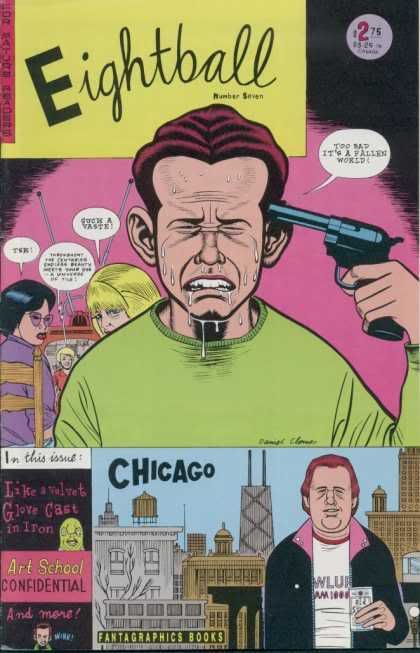 : Featuring "Art School Confidential," "Chicago," and, yes, "Needledick the Bug Fucker." The first time I read this, I realized how people could talk about how reading Mad back in the '50s could completely change the way they saw everything.
: Featuring "Art School Confidential," "Chicago," and, yes, "Needledick the Bug Fucker." The first time I read this, I realized how people could talk about how reading Mad back in the '50s could completely change the way they saw everything.
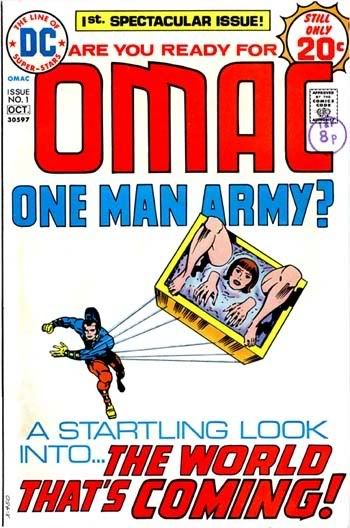 Omac #1: If you had to pick one last superhero comic to read, this would be the one. Every panel of this is jammed with subtext and possibility. Even the rest of the Kirby issues aren't half as good as the comic series that exists in your brain after you've read this one issue.
Omac #1: If you had to pick one last superhero comic to read, this would be the one. Every panel of this is jammed with subtext and possibility. Even the rest of the Kirby issues aren't half as good as the comic series that exists in your brain after you've read this one issue.
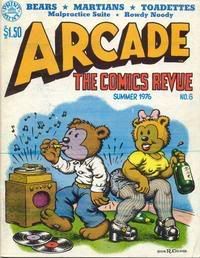 Arcade #6: The first comic where I finally "got" Crumb, but it's also got Spiegelman's 'Malpractice Suite,' which still floors me. And S. Clay Wilson! And Bill Griffith! And Rory Hayes! And Mark Beyer! Pretty much bifurcated into Weirdo and Raw, both of which I loved, but never quite in the same way I loved this.
Arcade #6: The first comic where I finally "got" Crumb, but it's also got Spiegelman's 'Malpractice Suite,' which still floors me. And S. Clay Wilson! And Bill Griffith! And Rory Hayes! And Mark Beyer! Pretty much bifurcated into Weirdo and Raw, both of which I loved, but never quite in the same way I loved this.
 Sam & Max's Freelance Police Special #1: The inspiration for Hit The Road and one of my picks for all-time funniest comic book. Most of my perfect comic book picks were chosen by how many times I've read and reread them; this issue of Sam & Max has to be in the double digits by now.
Sam & Max's Freelance Police Special #1: The inspiration for Hit The Road and one of my picks for all-time funniest comic book. Most of my perfect comic book picks were chosen by how many times I've read and reread them; this issue of Sam & Max has to be in the double digits by now.
5 Writers Whose Work For Marvel in the '70s I'll Always Adore
Steve Gerber: Yeah, that's probably a given.
Steve Englehart: Somewhere tucked away in my brain is an essay about how Englehart made comic contuity work in a way that fooled just about everyone into thinking it was an easy and positive benefit to superhero universes than it actually is.
Don McGregor: My goal for this year is to re-read Panther's Rage, which was pretty much my version of Watchmen when I was, I dunno, nine? And review it here, is the plan.
Doug Moench: Overwrought? All these guys were overwrought--it came with the territory. But Moench's overwroughtness also underscored the fact that he seemingly took every assignment seriously, be it Planet of the Apes, dialoguing duties on Rich Buckler's Deathlok, Godzilla, or, of course, Master of Kung-Fu.
Chris Claremont: Claremont was pretty much the last and latest of this generation and, of course, by far the most successful. For better or for worse, so many of the techniques (both strengths and weaknesses) of the '70s Marvel writers found their apotheosis in Claremont's work on Uncanny X-Men.
5 Portrayals of Comic Characters in Other Media I Love More Than The Originals
Buster Crabbe's Flash Gordon: I saw these serials when I was really young and they were perfect. I wish I could show you what I see in my mind when I think back on these.
Robert Downey Jr.'s Tony Stark: Yeah, absolutely. Tony Stark of the comics is pretty much a whiny beeyotch, when he's not being painted as a great big tool. RDJ somehow transcends all of that, while remaining faithful to it? Like, how the hell did he do that?
Chris Evans' Johnny Storm: Kinda similar to the above. Never liked Johnny Storm until Evans gave him crack comic timing.
300 The Movie: Zack Snyder's 300 is so much better than Miller's 300, I think, in the same way Pierre Menard's Quixote is so much better than Cervantes' Quixote.
(I'm shocked I left both Heath Ledger's Joker and Bava's Danger: Diabolik off this list. But that speaks to how much I love the original material, I guess.)
5 More Perfect Comics, With Far Less Commentary
Acme Novelty Library #1: Barely edging out that one awesome issue where Jimmy, his Mom and Superman get stuck on a desert island (and mainly because I can never remember the issue number on that one).
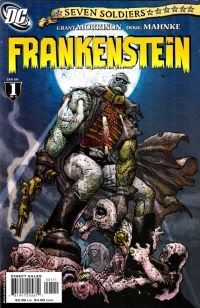 Seven Soldiers: Frankenstein #1: Barely edging out Seven Soldiers #1.
Seven Soldiers: Frankenstein #1: Barely edging out Seven Soldiers #1.
Swamp Thing #32: "Pog."
Love & Rockets #4: the conclusion of the first Heartbreak Soup story and 100 Rooms.
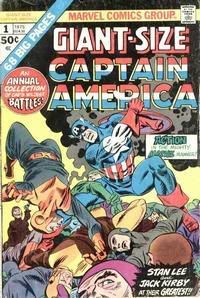 Giant-Size Captain America #1: A collection of Lee & Kirby Cap stories that were just excuses for Kirby to draw fight scenes for six or seven pages at a stretch. True comic book crack: I didn't even have an opinion about it the first 15 times I read it.
Giant-Size Captain America #1: A collection of Lee & Kirby Cap stories that were just excuses for Kirby to draw fight scenes for six or seven pages at a stretch. True comic book crack: I didn't even have an opinion about it the first 15 times I read it.
Twenty Other Things I Like About Comics, Unsorted & Without Comment:
Paul Pope
Angel & The Ape
The Fortress of Solitude
Dr. Slump
"Tricky Cad"
Skull the Slayer
Those Giant Working Props (in Finger & Sprang's Batman?)
Analogues of corporate controlled characters
Letter pages by Ennis and Morrison
Ghost Rider
Guido Crepax
Snoopy's Doghouse
The Giant Gil Kane Heads o' Drama
Sgt. Frog
Bêlit
Kirby fingers
Golgo 13
The initials "LL"
Alan Moore's beard
The comics blogosphere











